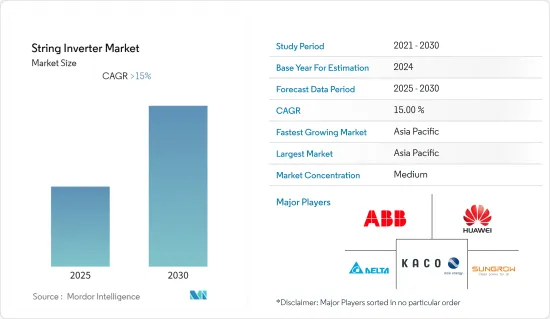
|
시장보고서
상품코드
1630385
스트링 인버터 : 시장 점유율 분석, 산업 동향 및 통계, 성장 예측(2025-2030년)String Inverter - Market Share Analysis, Industry Trends & Statistics, Growth Forecasts (2025 - 2030) |
||||||
스트링 인버터 시장은 예측 기간 동안 15% 이상의 CAGR을 기록할 것으로 예상됩니다.

COVID-19는 2020년 시장에 부정적인 영향을 미쳤습니다. 현재 시장은 대유행 이전 수준에 도달할 가능성이 높습니다.
주요 하이라이트
- 장기적으로 태양광발전 프로젝트 확대, 정부 지원책, 태양광 부품 가격 하락 등의 요인이 시장을 견인할 것으로 보입니다. 세계 각국 정부는 대체 에너지원으로 재생에너지를 도입하기 위해 다양한 정책을 도입하고 있습니다.
- 한편, 저개발 국가와 신흥 경제국에서는 주택 부문에 태양광발전(PV) 시스템을 설치하기 위한 자금 조달 옵션의 필요성이 예측 기간 동안 스트링 인버터 시장의 성장을 저해할 것으로 예상됩니다.
- 향후 몇 년간 온실가스(GHG) 배출량 감축 목표에 따라 세계 각국은 기후변화를 완화하기 위해 다양한 목표를 채택하고 있습니다. 예를 들어, 미국 캘리포니아주는 2030년까지 온실가스 배출량을 40% 감축하는 것을 목표로 하고 있습니다. 또한, 2030년까지 전 세계 전력 수요는 시간당 36,000테라와트에 육박할 것으로 추정됩니다. 전력 수요 증가와 온실가스 배출량 목표는 태양광발전과 같은 재생에너지 설비의 증가를 촉진할 것으로 예상되며, 이는 가까운 미래에 스트링 인버터 기업이 사업을 확장할 수 있는 기회를 창출할 가능성이 높습니다.
- 아시아태평양은 예측 기간 동안 큰 폭의 성장이 예상되며, 대부분의 수요는 중국, 일본, 인도에서 발생할 것으로 예상됩니다.
스트링 인버터 시장 동향
큰 성장이 기대되는 공공사업 부문
- 공익사업 및 대규모 태양광발전 설비는 수 에이커의 토지를 커버하는 대규모 프로젝트로, 오로지 배전 목적으로만 전력을 생산합니다. 스트링 인버터는 태양전지판에서 생성 된 직류(DC)를 교류(AC)로 변환합니다.
- 공공 및 대규모 태양광발전 시설은 집광형 태양광발전(CPV), 집광형 태양열 발전(CSP), 태양광발전(PV)을 포함한 여러 기술을 통해 전기를 생산합니다. 그 중 태양광발전은 스트링 인버터가 가장 널리 도입된 기술입니다.
- 2021년 전 세계 태양광발전 설비용량은 약 940기가와트(GW)에 달할 것으로 예상되며, 지속가능하고 저렴한 에너지원을 확보하기 위해 각국이 취한 다양한 노력으로 예측 기간 동안 증가할 것으로 예상됩니다.
- 공공사업 부문의 스트링 인버터는 주로 삼상이며 정격 출력이 80kW 이상이며 극한의 기후 조건을 견딜 수 있는 고유한 특성을 가지고 있습니다. 수요 증가에 따라 태양광발전 사업에 대한 투자는 해마다 증가하고 있습니다. 중국과 미국과 같은 국가는 향후 몇 년 동안 많은 유틸리티 프로젝트를 수행하는 데 집중하는 상위 국가 중 하나입니다.
- 또한 2022년 9월, 미국에 기반을 둔 몇 안 되는 태양광 인버터 제조업체 중 하나인 야스카와 솔렉트리아 솔라(Yaskawa Solectria Solar)는 퍼스트 솔라(First Solar)와 파트너십을 맺었습니다. 양사는 First Solar의 박막 카드뮴 텔루르화 카드뮴 태양전지 모듈을 위해 Solectria XGI 1500-250 실용 규모의 스트링 인버터를 최적화하기 위해 협력하고 있습니다. 이번 파트너십은 접지된 DC 입력을 가능하게 하는 새로운 XGI 1500-250 실사용 규모 스트링 인버터의 버전을 만드는 것을 목표로 하고 있습니다.
- 이러한 유틸리티 부문의 노력은 스트링 인버터의 대규모 설치로 이어져 예측 기간 동안 시장 지배력에 기여할 것으로 보입니다.
아시아태평양이 급성장하고 있습니다
- 아시아태평양은 태양광발전과 스트링 인버터 설치 용량이 가장 많은 지역으로 2021년 이 지역의 태양광발전 설비 용량은 484.930기가와트(GW)에 육박할 것으로 예상되며 중국, 일본, 인도가 주요 국가로 꼽힙니다.
- 중국은 2021년 약 306.56GW의 태양광발전 설비가 설치될 것으로 예상되는 이 지역의 주요 국가입니다. 중국은 2025년까지 설치 용량을 두 배로 늘릴 계획이며, 예측 기간 동안 스트링 인버터 시장을 확대할 가능성이 높습니다.
- 또한 중국의 Tengger Desert Solar Park, Longyangxia Dam Solar Park, 인도의 Kurnool Ultra Mega Solar Park, Kamuthi Solar Power Station은 이 지역에서 스트링 인버터가 도입한 몇 안 되는 주요 프로젝트입니다.
- 또한 2022년 7월, Kehua Data는 자사의 SPI 시리즈 1500V/350kW 스트링 인버터가 고전압 승차 통과(HVRT) 검사 및 저전압 승차 통과(LVRT) 검사를 통과하고 인증 보고서를 한 번에 획득했다고 발표했습니다.
- 또한 2022년 6월, 진롱(Solis) 테크놀러지는 29억 2,500만 위안의 투자를 발표했으며, 이는 스트링 인버터와 분산형 태양광발전소 프로젝트 생산에 사용될 것으로 예상됩니다. 발표에 따르면, 연간 95만 대의 스트링 인버터를 생산할 신규 프로젝트의 총 투자액은 1억 6,000만 달러로 추정됩니다.
- 이상의 점과 최근 동향으로 미루어 볼 때, 아시아태평양은 예측 기간 동안 스트링 인버터 시장을 독점할 것으로 예상됩니다.
스트링 인버터 산업 개요
스트링 인버터 시장은 적당히 세분화되어 있습니다. 시장의 주요 기업(순서는 무관)으로는 KACO New Energy GmbH, Delta Energy Systems GmbH, ABB Ltd, Sungrow Power Supply, Huawei Technologies, Chint Power Systems, Ningbo Ginlong Technologies, Fronius International GmbH, SMA Solar Technology AG, Eaton Corporation Plc 등이 있습니다.
기타 혜택
- 엑셀 형식의 시장 예측(ME) 시트
- 3개월간의 애널리스트 지원
목차
제1장 소개
- 조사 범위
- 시장 정의
- 조사 가정
제2장 주요 요약
제3장 조사 방법
제4장 시장 개요
- 소개
- 2027년까지 시장 규모와 수요 예측 : 10억 달러
- 최근 동향과 개발
- 정부 규제와 시책
- 시장 역학
- 성장 촉진요인
- 성장 억제요인
- 공급망 분석
- Porter's Five Forces 분석
- 공급 기업의 교섭력
- 소비자의 협상력
- 신규 참여업체의 위협
- 대체품의 위협
- 경쟁 기업 간의 경쟁 강도
제5장 시장 세분화
- 상
- 단상
- 삼상
- 정격출력
- 10kW 이하
- 11-40kW
- 41-80kW
- 80kW 이상
- 최종사용자
- 주거용
- 상업·산업
- 유틸리티
- 지역
- 북미
- 아시아태평양
- 유럽
- 남미
- 중동 및 아프리카
제6장 경쟁 구도
- M&A, 합작투자, 제휴, 협정
- 주요 기업의 전략
- 기업 개요
- KACO New Energy GmbH
- Delta Energy Systems GmbH
- ABB Ltd.
- Sungrow Power Supply Co Ltd.
- Huawei Technologies Co. Ltd.
- Chint Power Systems Co. Ltd.
- Ningbo Ginlong Technologies Co Ltd
- Fronius International GmbH
- SMA Solar Technology AG
- Eaton Corporation Plc.
제7장 시장 기회와 향후 동향
ksm 25.01.23The String Inverter Market is expected to register a CAGR of greater than 15% during the forecast period.

COVID-19 negatively impacted the market in 2020. Presently the market is likely to reach pre-pandemic levels.
Key Highlights
- Over the long term, factors such as the increasing deployment of solar projects, supportive government initiatives, and the declining price of solar photovoltaic components are expected to drive the market. Governments worldwide have incorporated various policies to implement renewable energy as a source of alternative energy.
- On the other note, the need for financing options to install solar photovoltaic (PV) systems in the residential sector in underdeveloped and developing economies is expected to hinder the string inverter market growth during the forecasting period.
- With the targets to reduce Greenhouse Gas (GHG) emissions in the coming years, countries across the globe are adopting various targets to mitigate climate change. For instance, California, one of the prominent states in the United States, has targeted reducing greenhouse gas emissions to 40% by 2030. Moreover, it is estimated that by 2030, the global electricity demand will be nearly 36 thousand terra watts per hour. The increasing demands for electricity clubbed with the targets for GHG emissions are expected to promulgate the increase in renewable energy facilities like solar PV, which is likely to create an opportunity for the string inverter companies to expand its business in the near future.
- Asia-Pacific is expected to witness significant growth during the forecast period, with most of the demand coming from China, Japan, and India.
String Inverter Market Trends
Utility Segment Likely to Witness Significant Growth
- Utility-Scale solar photovoltaic installations are massive projects covering multiple acres of land to generate electricity solely for distribution purposes. The string inverters convert the generated Direct Current (DC) by the solar panels into Alternating Current (AC).
- The utility-scale solar facilities generate electricity through several technologies that include Concentrating Photovoltaics (CPV), Concentrating Solar Power (CSP), and Photovoltaics (PV). Among all, photovoltaic is the most widely implemented technology on which string inverters are getting used.
- In 2021, global solar PV installed capacity was nearly 940 gigawatts (GW) and was expected to increase during the forecast period on account of various initiatives taken by the countries to have a sustainable and cheaper form of energy source.
- Utility segment string inverters are primarily three-phase, have a power rating of more than 80kW, and have unique properties to withstand extreme climatic conditions. With increasing demand, investment in solar utility projects has been growing over the years. Countries like China and the United States are among the top countries concentrating on having many utility projects in the upcoming years.
- Moreover, in September 2022, Yaskawa Solectria Solar, one of the few US-based manufacturers of solar inverters, formed a partnership with First Solar. Both companies are working to optimize the Solectria XGI 1500-250 utility-scale string inverters for First Solar's thin-film cadmium telluride solar modules. The partnership aims to create a version of the new XGI 1500-250 utility-scale string inverter that allows a grounded DC input.
- Such steps in the utility sector are likely to have a large installation of string inverters and thus help dominate the market during the forecast period.
Asia-Pacific to Witness Significant Growth
- Asia-Pacific is dominating the region with the highest installed capacity of solar PV and string inverters. In 2021, the region has nearly 484.930 gigawatts (GW) of solar PV installed capacity, with China, Japan, and India as the major countries.
- China is the major country in the region with approximately 306.56 GW of solar installations in 2021. It is expected that the country is planning to double its installation capacity by 2025, which is likely to expand the string inverter market during the forecast period.
- Also, Tengger Desert Solar Park, Longyangxia Dam Solar Park of China, Kurnool Ultra Mega Solar Park, and Kamuthi Solar Power Station of India are the few key projects in the region that have installed string inverters.
- Moreover, in July 2022, Kehua Data Co., Ltd. has announced that its SPI series 1500V/350kW string inverter passed the High Voltage Ride Through (HVRT) and Low (zero) Voltage Ride Through (LVRT) tests and obtained the certification report at one time.
- Furthermore, In June 2022, Ginlong (Solis) Technologies Co. Ltd announced an investment of CNY 2.925 billion, which is expected to be used for the production of string inverters and distributed photovoltaic power station projects. According to the announcement, the total investment of the new project with an annual output of 950,000 units of string inverters is estimated to be USD 0.160 billion.
- Owing to the above points and the recent developments, the Asia-Pacific region is expected to dominate the string inverter market during the forecast period.
String Inverter Industry Overview
The String Inverter Market is moderately fragmented. Some of the key players in the market (not in particular order) include KACO New Energy GmbH, Delta Energy Systems GmbH, ABB Ltd, Sungrow Power Supply Co Ltd, Huawei Technologies Co. Ltd., Chint Power Systems Co. Ltd., Ningbo Ginlong Technologies Co Ltd, Fronius International GmbH, SMA Solar Technology AG, and Eaton Corporation Plc.
Additional Benefits:
- The market estimate (ME) sheet in Excel format
- 3 months of analyst support
TABLE OF CONTENTS
1 INTRODUCTION
- 1.1 Scope of the Study
- 1.2 Market Definition
- 1.3 Study Assumptions
2 EXECUTIVE SUMMARY
3 RESEARCH METHODOLOGY
4 MARKET OVERVIEW
- 4.1 Introduction
- 4.2 Market Size and Demand Forecast USD billion, till 2027
- 4.3 Recent Trends and Developments
- 4.4 Government Policies and Regulations
- 4.5 Market Dynamics
- 4.5.1 Drivers
- 4.5.2 Restraints
- 4.6 Supply Chain Analysis
- 4.7 Porter's Five Forces Analysis
- 4.7.1 Bargaining Power of Suppliers
- 4.7.2 Bargaining Power of Consumers
- 4.7.3 Threat of New Entrants
- 4.7.4 Threat of Substitute Products and Services
- 4.7.5 Intensity of Competitive Rivalry
5 MARKET SEGMENTATION
- 5.1 Phase
- 5.1.1 Single Phase
- 5.1.2 Three Phase
- 5.2 Power Rating
- 5.2.1 Up to 10kW
- 5.2.2 11kW to 40kW
- 5.2.3 41kW to 80kW
- 5.2.4 Above 80kW
- 5.3 End-User
- 5.3.1 Residential
- 5.3.2 Commercial & Industrial
- 5.3.3 Utility
- 5.4 Geography
- 5.4.1 North America
- 5.4.2 Asia-Pacific
- 5.4.3 Europe
- 5.4.4 South America
- 5.4.5 Middle-East and Africa
6 COMPETITIVE LANDSCAPE
- 6.1 Mergers and Acquisitions, Joint Ventures, Collaborations, and Agreements
- 6.2 Strategies Adopted by Leading Players
- 6.3 Company Profiles
- 6.3.1 KACO New Energy GmbH
- 6.3.2 Delta Energy Systems GmbH
- 6.3.3 ABB Ltd.
- 6.3.4 Sungrow Power Supply Co Ltd.
- 6.3.5 Huawei Technologies Co. Ltd.
- 6.3.6 Chint Power Systems Co. Ltd.
- 6.3.7 Ningbo Ginlong Technologies Co Ltd
- 6.3.8 Fronius International GmbH
- 6.3.9 SMA Solar Technology AG
- 6.3.10 Eaton Corporation Plc.
















